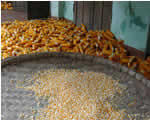- Animal health
- Animal Nutrition
- Genetic and Biodiversity
- Environment and natural resources protection
- Socio-economy in pig production sector
- Quality and food safety
- Animal husbandry and sustainable practices
- Rural Development
For further information
Maize commodity chain in Northern Vietnam | An overview of the maize sector situation
An overview of the maize sector situation in Vietnam, the structure and functioning of the commodity chain in North Vietnam based on original data collected by interviews of actors involved in this commodity chain. the main difficulties and opportunities for the development of this commodity chain in relation with animal husbandry development are raised and strategies for maize sector in Vietnam discussed.
Introduction
Rural agriculture development and the transition of economic structure are the main issues of the Vietnamese strategy of social-economic development. Resolution No6-NQ/TW dated November 10th 1998 of Ministry of Politic stated that animal husbandry should become a main activity of agricultural economy. This is a great challenge not only for animal husbandry itself but also for vegetable production through feed production.
Animal feed, which maize is a basic ingredient for pigs or poultry, represents 60-70% of meat production price. The reduction of the feeding cost is one of the major issue for the development of the pig sectors, and animal raising, in Vietnam. During the last decade, breeding animals with products cultivated in the farm household has gradually been replaced by many farmers by breeding with animal feed bought in the market. This evolution of feeding practice has made maize widely used in pig ration.
Recent research carried out by the Agrarian System Department (ASD) – Vietnam Agricultural Science Institute (VASI) in cooperation with Cirad (Centre International de la Recherche Agronomique pour le Développement) and Gret (Groupe d’Echange Technologique) on the increase of animal feed ration showed that the development of pig breeding has close connection with maize commodity chain. This mutual relationship becomes more important as farmers develop lean pig breeding for domestic or export markets. Research on expanding animal husbandry then goes together with research on feed resources. Thus, maize commodity chain becomes a necessary research object.
This article aims to raised specific issues for further development of the maize commodity chain. After an overview of the maize sector situation in Vietnam based on available secondary data, this article presents the structure and functioning of the commodity chain in North Vietnam based on original data collected by interviews of actors involved in this commodity chain. Based on this analyze, the main difficulties and opportunities for the development of this commodity chain in relation with animal husbandry development are raised and strategies for maize sector in Vietnam discussed.
Research method and scope
Method
A review of available documents on maize production in the whole country, import and export, domestic and world prices has been used to capture general situation of maize sector in Vietnam and in the Asia Pacific area and raise general issue.
The identification of the actors directly involved in maize commodity chain in North of Vietnam has been done through consultation of keys informants and some direct actors. In-depth interviews of a all kinds of actors involved in this commodity chain, from animal producers to maize producers has been used to grasp the structure and functioning of the commodity chain. A first phase of direct interviews focused on Red River Delta wholesalers and Retailers was designed to determine the characteristics of the market demand, the origin of the maize supply in the Red River Delta (RRD). It was completed with interviews of final users of maize, pig and poultry producers of the RRD, to find out their quality and quantity requirements in production process. A second phase consisted in a mobile investigation of maize circulation from maize producers in North West province, especially Son La and Hoa Binh, to maize consumers in the Red River Delta and a specific survey on maize producers in mountainous areas (Son La province) to address production situation and relationship with the market.
Research scale
Research were carried out in the north of Vietnam and covered Red River Delta and North West provinces. For the deltaic area, the main animal producing area in the north of Vietnam, survey were conducted in Thanh Tri district and Gia Lam district of Ha Noi province, Nam Sach district of Hai Duong province and Dan Phuong district and Hoai Duc district of Ha Tay province. For the maize producing area, Mai Son district of Son La province was selected.
Overview of maize sector in Vietnam
A rapid increase of maize production
As in most of the Asian countries like China, Thailand, Indonesia, Vietnamese maize production increased dramatically during the last decade following the rapid increase of animal feed demand. The Vietnamese maize production raised from 661.8 thousand tons in 1990 to 1,929.5 thousand tons, an impressive 11,2 % annual average growth rate.
This rapid increase resulted of both a rapid increase of sown area 5% per year and an increase of yield 5% per year. During the last years, maize production system expanded in all the 8 Vietnamese agro-ecological zones (Table 1). In 2000, maize was grown on 717.8 thousand hectares. The main producing regions are the North East Region in the north of Vietnam and North East South region in the south of Vietnam, that represent together almost 50 % of the total national production.
Table 1 :Evolution of Vietnamese maize production by agro-ecological zones between 1990 and 2000
| 1990 | 2000 | 1990-95 | 1996-2000 | 1990-2000 | |
| Red River Delta | 148.1 | 212.8 | 137.5 | 81.0 | 143.7 |
| North East | 192.9 | 485.5 | 149.8 | 134.0 | 251.7 |
| North West | 53.6 | 211.8 | 179.7 | 187.3 | 395.1 |
| North Central Coast | 58.3 | 227.6 | 197.1 | 149.4 | 390.4 |
| South Central Coast | 20.1 | 70.6 | 107.2 | 190.3 | 241.8 |
| Central Highland | 64.6 | 239.1 | 108.4 | 209.4 | 370.1 |
| North East South | 98.6 | 434.4 | 292.1 | 107.4 | 440.6 |
| Mekong River Delta | 25.6 | 47.7 | 328.1 | 52.7 | 186.3 |
| Whole Country | 661.8 | 1929.5 | 175.5 | 125.6 | 287.6 |
Although the increase of the production is noticeable in the all the agro-ecological regions, the pace of increase is highly different between areas. Over the last decade, deltaic regions registered a relative low rate of increase (less than 200 % between 1990 and 2000) compared with mountainous area (from 250 % to 440 % according the regions, between 1990 and 2000).
More over, it is noticeable that the pace of increase of the production is slightly decreasing. As it was around 14.5% per year during 1990-1995, it reduces to 10.4% between 1995 and 2000. This trend toward a relative slow down is particularly noticeable in the deltas, Red River Delta production grew at 81% from 1996 to 2000 and Mekong River Delta production at 52,7%. Only the midland or mountainous areas, as North West, South Central Coast and Central Highland regions, registered an increasing pace of growth in maize production during the last five years.
In the North, maize developed in all agro-ecological zones, but especially in Northern mountainous provinces. The recent development of production comes especially from development of intensive areas of maize production in Son La, Ha Giang, Thanh Hoa,... where maize is grown on sloping and wet land and where investments in new seeds dissemination (especially hybrids seeds like LVN10, DK88, etc…), fertilizers and pesticides use led to the rapid adoption of more productive systems.
An increasing imports of maize
In spite of a rapid development of the maize production, Vietnam, as most of the Asian countries , can’t cover the increasing demand for feed. According to FAO stat, Vietnamese demand for maize increases from some 640 thousand tons in 1990 in which 20% were for feed to some 1,900 thousand tons in 2000 in which feed represents 70%. Thus, if until 1995 the Vietnamese production was still exceeding the demand and Vietnam was then exporting maize, five year later, in 2000, Vietnam has become a net importer of maize with almost 200 thousand tons imported per year (Figure 1), that represents almost 25 millions USD.
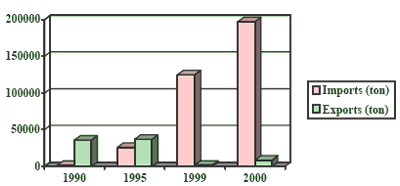
Figure 1 : Evolution of Vietnamese export and imports of Maize from 1990 to 2000 (source: FAO Stat)
In a context of a insufficient domestic production to meet the demand, the Vietnamese government reduced imports limitations. It alleviates the quotas on imports and set an import tax policy to support the national agricultural production. According to the Decision 34/2001/QD-BNN-VP, individual organizations with import and export licenses are allowed to import maize without a limitation of quantity and value but with a customs declaration. But, the imports are subject to a 7 % import tax and its quality must be guaranteed.
A decrease of domestic prices
With development of national maize production and the increase of imports, Vietnam’s maize domestic price is decreasing. In 2001, the average domestic maize price was then 35 % lower than domestic maize price of 1997. More over, the gap between Vietnam domestic and the world market price is narrowing (Table 2).
Table 2 : Price of maize in the free market of Vietnam and the world
| 1997 | 177 | n.a. | - |
| 1998 | 169 | 93 | 182% |
| 1999 | 160 | 84 | 190% |
| 2000 | 146 | 83 | 176% |
| 2001 | 115 | 84 | 137% |
Since the development of domestic production and imports led to a reduction of the domestic maize price, a further reduction of import tax level to 0 %, as other countries of the region already adopted following their commitments to free trade agreement, should increase the competition between domestic production and imports, further reduce the gap between domestic and international price and could lead to a further decrease of the domestic maize price. This could represent an unfavorable factor for domestic production especially when the pace of increase of domestic production seems is reducing.
Current situation of maize commodity chain in North of Vietnam
Main characteristics of the maize demand and supply in the Red River Delta
Red River Delta is the main region for animal husbandry in the North of Vietnam, especially in term of pig and poultry production. This animal production development is an opportunity for those farmers with small holding to generate incomes in land scarce area. If the maize production of RRD increased during the last decade, it can’t cover the rapid increase of animal raiser demand. The research of maize suppliers for the development of animal husbandry in RRD had then become essential and imperative.
The farmers’ demand in maize
In order to reduce their production costs, farmers tend to reduce their feeding cost. As industrial feed is expensive, they do prefer to rely on agricultural raw material. As maize grain or flour is a kind of feed with a relatively high value of nutrition compared to other feed, especially in term of protein content, farmers, especially farmers who develop lean pig production, tend to increase the maize proportion in their ration.
According to last investigations in Nam Sach animal husbandry service co-operative (Hai Duong province) and Cat Que communes, Hoai Duc district (Ha Tay province), maize accounts for 49% and 45% respectively in the rate of food. More over, as protein cost from maize is lower than the protein cost from other feed products, at current price, it is difficult to select some other feeding source to replace maize without a negative influence on their cost of production. Thus farmers demands is high toward a stable supply of maize all over the year.
Table 3 . Nutritional value of maize incomared with other raw materials in animal husbandry
| Maize | 9.54 | 10.05 | 2.83 | 1.95 | 1.95 | 76.68 | 3365 |
| Rice | 11.56 | 7.80 | 0.35 | 0.29 | 0.73 | 79.01 | 3320 |
| Rice bran | 9.96 | 10.98 | 11.08 | 11.91 | 8.56 | 45.94 | 2620 |
| Peanut | 8.21 | 39.84 | 1.33 | 6.60 | 7.10 | 36.91 | 2915 |
| Oil cake | 6.60 | 35.22 | 11.58 | 9.50 | 7.46 | 28.38 | 23.50 |
Origins of the maize supply and problem of availability in the Red River Delta
To meet users demands, aside local production, four major sources of maize supplied for the market of Red River Delta: the North West region (Son La, Hoa Binh provinces), the North Central Region (Thanh Hoa, Nghe An provinces), the provinces of the South of Vietnam and imported maize, mainly from China. The maize from Son La plays an important role in the market (Figure 2). However, the supply of maize is not stable among the months in a year. A shortage of maize supply in the market often occurs from April to August when there is no maize available from the North West region. During this shortage period, main source of maize is the North Central Region (Thanh Hoa, Nghe An, Quang Binh) and the imports mainly from China.
Nevertheless those alternative supply source doesn’t meet the demand of the final users – animal producers - especially in term of quality. According to the maize agents’ estimation, the maize from Thanh Hoa, Nghe An, Quang Binh are sold very expensively in Hanoi market, but their quality is poor in comparison with maize from Son La. Then few of them bought it. Imported Maize, coming mainly from China, is also trade during this shortage period but as for maize coming from North Central Region, the poor quality limits the trade activity.
More over, while the amount of maize grain on the market is very little, farmers’ and big agents’ maize storage is empty, reserve are concentrated in the feed processing companies and the food company but it is not enough to meet the demand of livestock producers in term of maize grain. If the domestic animal feed processing factories use imported maize as a supplied source, final users – animal producers - find it difficult to accept imported maize because it can bring risk for their work.
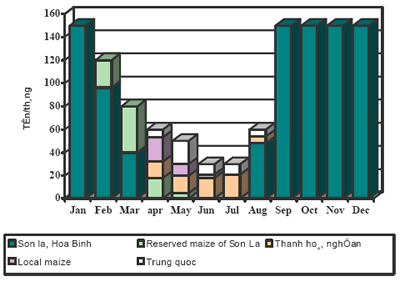
Figure 2 : Origin of Maize of a delta agent (source: VASI/CIRAD, survey 2002)
A preference for domestic maize from the North West
Based on the drying process (sun dried, or dried with driers) and the origin of the maize, animal husbandry farmers and feed processing factories, the main users of maize grain, distinguish 4 main kinds of maize grain (Table 4). Considering the quality of domestic maize better than imported one, consumers prefer to use the first one regardless of its higher price. Besides, the quality of maize dried by dryer is considered as lower than the sun-dried maize. However the price of the maize dried with dryer is higher because of its higher producing cost, but it is easier to store compared with sun-dried maize for which risk of going mouldy during transport and storage is high and is an impediment for long duration storage.
Table 4 : Maize quality characteristics
| Maize machine dried from Son La | Small round red grain, bright yellow corn flour, moisture content 14 – 15 % |
| Maize sun-dried from Son La province | Big red grain, yellow corn flour, moisture content 16 – 18 % |
| Maize from China | Small yellow-with grain, hollow in the middle of the grain |
| Maize from Thanh Hoa, Nghe An and south Vietnam | Small red grain, yellow corn flour, moisture content 15 –18 % |
Maize price instability
The price of maize in the market is often ups and downs and is rather closed related to other agricultural products, especially rice and pork (Figure 3). The relation between the price of maize and that of other products depends on other products’ replacement or supplement to maize in the food rate.
The market price of maize is not stable and depend on the harvesting season of maize collected from Son La and Hoa Binh. When Son La maize is harvested, the maize price in the market goes cheaper. Now, the development of the domestic animal food-processing factories purchase maize from Son La, Hoa Binh so the maize price is locally decided by the factories proposed price.
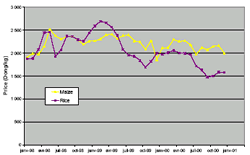
|
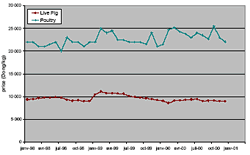
|
Figure 3 . Price of selected agricultural products on the RRD market (source: VASI-CIRAD survey, 2002)
Maize commodity chain structure and functioning
The Maize's main flows
Vietnamese of maize commodity chain has developed and extended since 1995 following the strong development of the demand in feed materials in the RRD and the development of maize production in the mountainous region linked with the hybrid maize adoption and improvement of technical practice. Nowadays, two main channels supply to the demand of the RRD: short local channel in the RRD and a long channel from Mountainous area to the RRD.
Since the maize production is often used within the farm household, a small surplus are mainly trade locally through local collectors that sell directly to animal producers within the commune or district (Figure 4). This local short channel still regulate the demand of some breeding households.

Figure 4 : The RRD’s local short channel
Aside of the local supply and short channel, a long channel developed during the last 5 years. It allows to supply RRD’s breeders by two ways, though maize grain or maize flour or through industrial feed (Figure 5). Those channels involved numerous actors : maize producers, assemblers, local wholesalers, carriers, RRD’s wholesalers, RRD retailers, and food company, feed processing factories, Feed wholesalers.
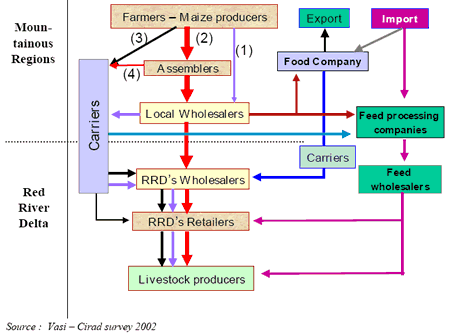
Figure 5 : Flow chart of maize trade from North Mountainous region to Red River Delta
Basic characteristics of the actors involved in maize commodity chain.
Quantity, quality, kinds of products and payment facilities are the main elements for the animal breeders to establish the relation with their supplier agents, mainly the RRD’s retailers. The RRD’s breeders often highly appreciate the domestic maize quality, especially the maize from Son La, since they have experienced disease problems with imported one due to toxin contaminations. Their demand upon maize commodity chain is to get have a stable supply in quantity and quality of the product all year round. Nevertheless, they had to adapt their ratio according to price and availability of products to lower their production cost. Considering that the quality of imported maize is low, they are reluctant to use it, so, during the maize shortage period, they turn back to rice-based ration or, when they had developed exotic breed animal raising, use industrial feed which led to an increase their production costs.
The RRD’s retailers trade always a variety of feed products. To get maize products to sell all over the year and avoid products shortages, they often establish linkages with several wholesalers who provide them with corn grain. They often possess a small milling device and sell to small breeders, mainly corn flour. On average, they sell from 8 to 10 tons of maize during the months of high availability from Son La province and from 3 to 5 tons during the period of maize shortage. With a low working capital and no or very low storage capacity, their main difficulty is to adapt rapidly their supply to the highly changing demand of their customers.
The RRD’s wholesalers always create themselves a stable commodity providers network in the producing area. They usually rely on 3 to 7 carriers, and from 5 to 7 local wholesalers in the regions such as Hoa Binh - Son La, Thanh Hoa - Nghe An and Hai Phong that concentrate maize products offer. The RRD’s wholesalers sell from 50 to 300 tons per month during the harvesting season of maize in the mountainous areas and reduce their activity to some 60 to 5 tons per month during the April to August period. They also have a network of customers, that consist in mainly RRD’s Retailers or sometimes animal breeders, to whom they often sell on credit. Those RRD’s wholesalers are concerned providing goods in time. They can go to other provinces to directly trade and buy products. They face difficulties in finding reliable providers during the period of shortage of local production.
The carriers are truck owners, who carry maize from mountainous maize producing regions to RRD. They usually have a seasonal activity that cover the maize harvesting period in Mountainous area. They develop relationships with a network of usually 5 to 10 local wholesalers or assemblers that provide them a stable supply. They also develop a network of 15 to 20 RRD’s wholesalers or retailers as well as sometimes feed companies. Although they establish relationships with RRD’s and local agents, carriers are sole actors of the commodity chain who directly pay their trading partners. Since they don’t pay so much attention to the quality of the products, they mainly complain about transportation taxes.
Quality and quantity of the product are not important elements to create relationships between local wholesalers and producers. Those relationships depend on the trading activities that they developed with farmers on other products, such as rice and production materials, before the maize harvesting time. Those local agents have a seasonal commercial activities on maize. They directly buy farmers’ production in the village and also create themselves a network of collectors about from 3 to 5 assemblers. Those local wholesalers often dry the maize products before selling back. A local wholesaler sell, on average, about from 1,000 to 1,500 tons per year of maize and have about from 7 to 10 seasonal labors per day specializing in drying maize corn. Some wholesalers have been supply with drying machine by food processing companies in order to increase product resource and quality (stability of the product). Although they have a low storage capability, these agents play a role in regulating the quantity of product sold on the market and determining selling price.
Assemblers are people who act at a local level (village). They have a fair knowledge of the situation of production in their region. There are two ways of collection: fixed collection and mobile collection. Fixed collection is carry out by collectors who work at the place they are living. They provide rice and materials to farmers and collect the production from their debtors or buy maize from them during the harvesting season. This type of assemblers can collect, on average, from 70 to 100 tons per year. Mobile assemblers have means of transportation, they can collect maize in more remote area and collect usually from 500 to 700 tons per year.
The RRD’s farmers plant maize mainly during the winter season on the wet land, usually in association with other crops. Their production is mainly dedicated for their own animal production but, although they obtain high yield, their production on small plot doesn’t cover the demand of their livestock production. They often have to buy maize from RRD’s retailers.
The producers in the highland and mountainous areas usually plant on the sloping land. Most of them plant maize as a single crop. The benefit from maize production contribute from 85% to 95% of income of the households (Vasi – Cirad survey 2002 in Son La province). They sell most of their production mainly as grain in the areas where they could rent a shelling device, and as a corn ears in remote areas. Those producers in a large majority (98%) don’t know where their product will be sold. Since they face cash flow problems and rely on formal and informal credits to buy inputs for production and to buy consumers goods, they have to sell their production just after the harvest and have thus a low bargaining power. Since they could find hybrid maize seed, they have few information on their chrematistics and have few ability to select it. Most of them complain about soil erosions that affect yield in a long trend.
Feed processing companies play an important role as the main buyers of the local production and as the main users of imported maize. Since other actors have a few storage facilities and low purchase capacity and thus are facing difficulties to find products out of the main harvesting season in the mountainous area, the feed processing companies are involved in both storage of local maize and imports during the shortage month to maintain their activities. To lower their procurement cost and have huge amount of local maize that they preferred to imported one in term of quality, they rely on a network of local agent to find products during the harvesting season and buy it during a low price period. Since they have the higher purchasing power in the commodity chain, their activities have a strong influence on price. Although they have high storage capacity, they still have to rely strongly on imports during the local shortage period to maintain their activity while RRD’s wholesalers have to reduce their activity during this period. To reduce their necessary imports, some of them invest in the development of local maize production (seeds, inputs,…) but all have interest in a decrease of import tax.
As feed companies, food companies play an import role in the maize commodity chain because they have the highest storage capabilities. They buy products from local wholesalers and could sell it to RRD’s wholesalers. They also imported maize during low availability period and could also export maize during the high availability period. Thus, they have an influence on price level and regulation but it still limited due to storage and capital endowment.
Table 5 : Main problems of the actors involved in maize commodity chain (source: VASI-CIRAD survey, 2002)
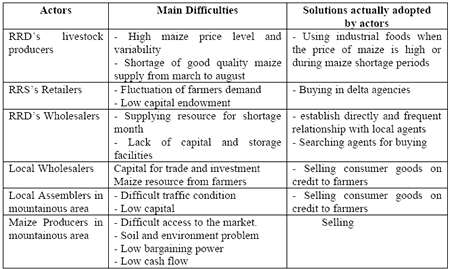
Economic results and share of repartition of effects of the actors
Economic results of the commodity chain from local mountainous producers show that farmer’s price represent from 66 to 76 % of consumers - livestock producers - price (Figure 6 a). The farmers that are near from market place and could sell directly to local wholesalers could have from 74 to 75 % of the final price and have then a better valorization of the production compared to those from remote areas. As for rice commodity chain (F Jesus, 2000), farmers have the highest margin in the commodity chain per kilogram, around 70%.
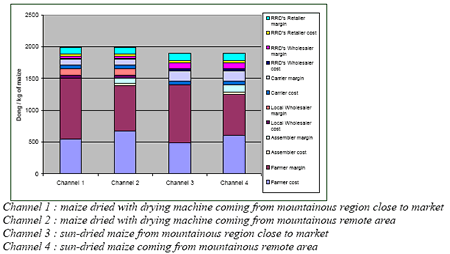
Figure 6 : cost and margin for selected channel of Maize commodity chain (source: VASI-CIRAD survey, 2002)
Nevertheless, the scale of activities affects directly the total income of each actors in the commodity chain. With annual average yearly trading volume of 1400 tons, RRD’s wholesalers are the actors who have the highest income level in the commodity chain for maize products , especially in the channel of sun-dried maize, that is from 6 to 20 times higher than farmer’s income.
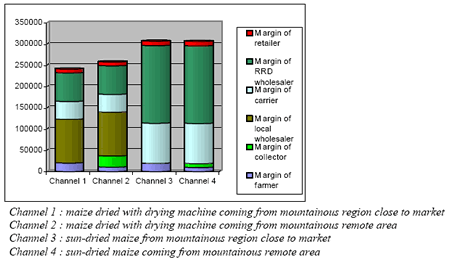
Figure 7 : Total incomes of actors in the maize commodity chain (source: VASI-CIRAD survey, 2002)
Difficulties, advantages and prospect for the development of the Maize commodity chain
Based on the analysis of the commodity chain structure and functioning, advantages, difficulties and prospective for development of the maize commodity chain could be raise as follow.
Advantages
The advantages for maize commodity chain development can be summarize as follow:
- a high and rapidly increasing demand especially for feed linked with animal products development
- A wide network of consumers,
- An user preference for Vietnamese maize compared with imported one,
- Producers get a high income from planting maize,
- commodity chain actors have relative ties that create many diversified and stable networks.
Difficulties
The main difficulties of the maize commodity chain in the North of Vietnam could be summarize as follow :
- Shortage of maize supply for Red River Delta market when the maize of North West region is not harvested,
- Storage system is not enough to apply market demand,
- Production price is high,
- Farmers face soil erosion.
Prospect of the commodity chain
- Maize commodity chain is facing a challenges of quantity and quality of maize as well as production price in order to apply the demand of animal husbandry and meet further competition with imported maize.
- Breeders and delta agents can have stable connections of quantity and quality, making the stability for their production activities.
- Intensive maize production system raise an environmental issue in term of soil erosion in sloping area.
Discussion on strategies
In a context of gradual reduction of maize exports by other Asian countries like China and Thailand to supply their own domestic demand in animal feed, a decreasing pace of increase of domestic maize production, a rapid and costly increase of imports and a reduction of domestic maize price, Vietnam has to define a strategy for maize sector and decide either to produce maize or imports maize to meet the increasing of the domestic demand. Three main strategies could be considered to cope with the increasing demand in maize of the animal raisers (Table 6).
Table 6 : opportunities and risk of possible strategies
| Support the development of national production through intensification | - Yield still low compared with potential. - Farmers have a fair level of experience and with much experience are able to approach market of producing materials. - Local maize is preferred by the consumers - Provide employment for rural labour force and local industries - Improving income for farmers, especially those in mountainous area where poverty level is important. |
|
| Strategy of import | - Free trade agreement - rapid response to meet the domestic demand, - reduce the cost of animal feed - limit problems of environment degradation. |
- High level of dependence of Vietnamese market on the world market. - A large number of agriculture workers are unemployment, - finding resource for animal husbandry. |
| Developing national production and imports if necessary | - Supply a sufficient amount of raw material for breeding. - Develop domestic production, solve the problem of rural employment, improve the farmer’s livelihood. - Not depend much on the world market, Vietnam still control the market when the world market changes. |
- Problems of competition between domestic maize product and imported one. - Necessary to manage closely and logically the relationship between production and environment conservation |
In present tendency, strategy of developing production and importing if necessary could represent the most advantage way because it relies on the potential of agriculture development and contribute to solve the problem of rural employment. However, to face competition with world market and reduce ecological risk, further actions are needed to design, adapt and broadcast improvement of maize production system (seed, cropping practice) that allow to increase productivity, reduce producing cost and conserve the environment.
Conclusion
Preliminary analysis of the maize structure and functioning of the maize commodity chain in northern Vietnam shows that the development of maize production and trade is strongly related to the development of animal production.
In the context of rapid increase of the demand for feed, recent policy and the involvement of local actors, as well as international actors as feed companies, led to a rapid development of domestic production and market that combined with imports enable to respond roughly to the animal raisers needs through a quiet efficient network of traders.
Nevertheless, domestic production could yet cover the users demand in maize grain. Vietnamese breeders still have a high demand for domestic maize grain, considered to have a higher quality and to be less risky than imports one, but they still face many difficulty to have a stable supply all year round. Moreover, although a huge and diversify network of agents developed to supply this demand, the maize grain market is controlled by food company and processing factories that have enough capital to buy domestic production during the harvest time in the main producing area. This lead to increase the scarcity of domestic maize grain out of the harvesting period in northwest region in the feed distribution network and thus is an impediment for animal breeders in reducing their production cost through direct use of raw materials instead of industrial feed.
In this context, considering that there still a high potential demand to be covered by the national production and that maize production and commodity chain is an opportunity for rural development especially for poor mountainous areas and the risk of increasing imports due to further integration to international trade, a strategy to strengthen national commodity chain and develop national production could be considered as the most favorable to respond to both necessity to improve productivity of raisers in the RRD and imperative development of poorer area, as mountainous ones. If a consensus could be raised from national actors about this necessity, more attention should be pay by the State to the development of this commodity chain and its stronger involvement is needed to develop this strategy. In this frame, further investments in research in term of sustainable practices of maize on slopping land to address erosion risks is needed. It should be coordinated with improvement of access to capital, techniques and knowledge for farmers involved in maize production. Several options to supply the demand of good quality grain during the shortage period from April to August as to be further evaluate and discuss among stakeholders such as the development of new producing areas, the improvement of the storage capacities, the quality improvement of maize coming from alternative producing area as North Central Region. More over, involvement of researcher and state is needed to help actors in designing of new institutional arrangement between farmers or farmers organizations and local trading agents to stabilize maize grain supply in term of quantity and quality. Lastly, the development of a model at a larger scale that allows to simulate the effect of state policy reforms and further integration of Vietnamese economy to international economy, on the welfare of both the maize producers, especially in poor rural mountainous area, and the animal raisers in deltaic areas, as well as the macroeconomic situation is needed. It could then help to the maize sectors stakeholders with government policy-maker to design in a collaborative way policy reforms at a larger scale that take into account economic (rapid development), geographic (differentiation among regions), social (differentiation of farmers incomes) and environmental (low erosion,…) issues.
Bibliography
- Jesus et al., (1999) – Ecopol project, results of phase I – Cirad, Vasi, mimeo - 53 p.
- Le Coq JF, F. Jesus, Bourgeois R., Le Thi Nham, Vu Trong Binh, (2002). Filière porc dans le Delta du Fleuve Rouge : Identification des enjeux et recherche de solutions en concertation – communication séminaire «Des approches innovantes au service du développement agricole » , Ha Noi, septembre 2002.
- Vu Trong Binh (2002). La qualité des porcs dans le nord du Viêt-Nam (Delta du Fleuve Rouge) Entre organisation des producteurs et évolution des systèmes de production’’. Thèse de doctorat INA P-G.
Comments
CIRAD © 2007 (All rights reserved) - Disclaimer stating - Page updated : 02/05/2007
